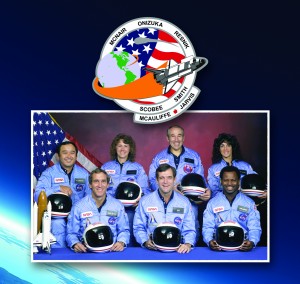Honoring the Heroes of the Challenger Space Shuttle—30 Years Later
 On January 28, 1986, five astronauts and two payload specialists boarded the Challenger space shuttle at the Kennedy Space Center. This would be the shuttle’s tenth mission, but this trip was going to be particularly special because of who was on board.
On January 28, 1986, five astronauts and two payload specialists boarded the Challenger space shuttle at the Kennedy Space Center. This would be the shuttle’s tenth mission, but this trip was going to be particularly special because of who was on board.
THE FIRST TEACHER IN SPACE
In 1984, President Ronald Reagan announced the Teacher in Space Project. One teacher would be selected to be the first private citizen to travel to space with the goal of sharing the experience with the public through education. The selected teacher would conduct two live lessons as well as three student-created experiments while aboard the Challenger, and this information would be filmed and then shared with classrooms around the country.
Over 11,000 teachers applied for the opportunity. After several rounds of meetings and interviews, Sharon Christa McAuliffe was selected as the primary candidate for the NASA Teacher in Space Project. McAuliffe took a year-long leave of absence from her teaching job at Concord High School in Concord, New Hampshire, in order to train for the mission.
AN A+ SPACE SHUTTLE CREW
Also part of this Challenger mission along with McAuliffe were commander Francis R. (Dick) Scobee, pilot Michael J. Smith, mission specialist Judith A. Resnick, mission specialist Ronald E. McNair, mission specialist Ellison S. Onizuka, and payload specialist Gregory B. Jarvis.
Scobee entered the U.S. Air Force right out of high school and received his pilot’s wings in 1966. As a test pilot for the Air Force, he flew more than 45 types of aircraft and logged more than 6,500 hours of flight time. He was also the pilot of the Challenger’s fifth mission in 1984.
Smith was a commander in the U.S. Navy and received his wings in 1969. He flew 28 different types of aircraft and logged more than 4,300 hours of flying time. Smith was selected as a NASA astronaut in 1980 and the 1986 Challenger mission was to be his first space flight.
Resnick was selected as a NASA astronaut in 1978, part of the first cadre containing women. She became the second American woman in orbit as part of the 1984 Discovery mission, where she helped to deploy three satellites.
McNair was high school valedictorian and went on to study physics at MIT. NASA selected McNair to enter the astronaut cadre in 1978, one of the first three African Americans to be selected. He was the second African American in space.
Onizuka served in the Air Force for eight years, first as an aerospace flight test engineer and then as chief of the engineering support section. He was selected as a NASA astronaut in 1978. His first space flight was in 1985 on the Discovery.
Jarvis, like McAuliffe, was not a federal government employee. He worked for Hughes Aircraft Corp.’s Space and Communications Group. Jarvis competed against 600 other people at Hughes to be accepted into their astronaut program.
TRAGEDY IN THE SKY
After months of training together, the seven crewmembers were ready for takeoff. Thousands of people around the country were watching the Challenger on TV when, just 73 seconds after takeoff, the shuttle broke apart and all seven lives were tragically lost.
It was a terrible loss for the NASA space program, but it encouraged them to keep going. Unraveling the mysteries of outer space is something people have been trying to do for centuries, but there is still so much more to be discovered. NASA—along with space programs in other countries—has continued to send people into space to conduct more experiments and learn more about our universe and beyond.
TOUCHING THE FUTURE
Being at the forefront of scientific discovery can be challenging, and sometimes even frightening. But there is always more to learn about the world around us and how we can use science to make the world a better and safer place.
The DuPont Challenge has honored the Challenger crew for the last 30 years. We encourage the next generation of students to push past current boundaries and uncover the next great scientific innovation. McAuliffe and the other Challenger crewmembers were assigned their mission to “touch the future” through the lessons taught in space. Every teacher has the opportunity to “touch the future” by encouraging their students to keep innovating.
